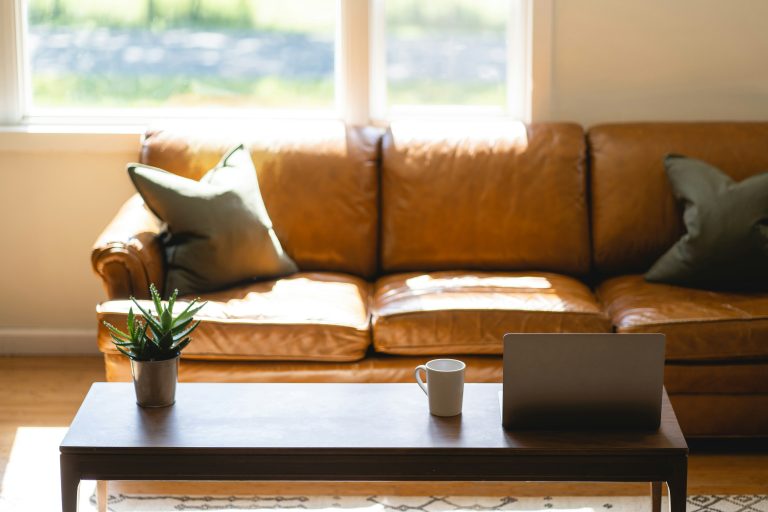If you’ve ever considered how to create the best living room for your home, it’s likely that you’ve pondered over how to pick a coffee table. After all, it’s no small feat, often being the make or break of your living room aesthetic. To make it even harder, from wooden nesting tables to asymmetrical stone pieces, there are so many options out there!
Luckily, we’ve collated each of the key considerations you should bear in mind for your next purchase into this handy guide. So, grab a cuppa and read on for all the best tips from size and shape to finishing touches.
Size
The size of your coffee table should be top of your list. Too big, and you risk making your living space feel cramped and claustrophobic. Too small, and the furniture proportions feel more than a little off-kilter. Just right, and you’ve got yourself a functional and sleek piece of furniture that ties the space together whilst allowing for the perfect flow. But what’s the true golden ratio? The short answer is it depends, but allow us to explain further:
Height
Since your coffee table is likely to be in close proximity to your sofa, it is important to evaluate its height against that of the latter. Your average sofa (to the top of the seat cushion) is likely to stand at around 45-50cm tall, depending on your particular model, whilst a standard coffee table will reach around 40-45m. This pairing is perfect, keeping the height difference between the two within the practical ideal of around 1.5-5cm.
Nonetheless, varying heights can prove particularly impactful in certain living room schemes. For instance, a low coffee table (typically around 30-35cm tall) can serve to draw attention to your sofa and is particularly effective in trendsetting scandi-style spaces. On the other end of the scale, a coffee table that is taller than the sofa makes for the perfect centrepiece, recommended to add visual depth and intrigue to large, open rooms.
Whichever variation you opt for; it is a good idea to measure the height of your sofa properly to avoid any unwanted surprises once you get the coffee table in place. For flexibility, you can explore adjustable height options or even a nest of coffee tables – if you’re one to change your mind, or if you’re needing to satisfy multiple uses, these are a smart choice!
Width
An often-overlooked dimension, the width of your coffee table should allow for ample clearance around your sofa without sacrificing the all-important viewing position. An easy way to achieve that goldilocks width is to measure the length between your sofa and TV stand and then subtract around 120cm (75cm for optimal viewing and 45cm for clearance).
Length
Similar in principle to the height dimension, the length of your coffee table should allow for a cohesive feel without overwhelming the space, especially if you’re working with a smaller room. Typically, a good rule of thumb is to keep the table equal to or below 2/3 of the sofa’s length. So, if the average sofa length is roughly 220cm, you’re looking at a coffee table equal to or below 147cm long.
Shape
When it comes to how to pick a coffee table, the shape is where you can start to get your creative hat on. Whilst rectangular options can be great as a timeless and popular solution, there’s plenty more on the market these days.
For example, round coffee tables often prove their worth in compact spaces, offering a curved silhouette that contrasts with the angular demands of a box room or corner sofa. For longer sofas, an oval-shape can bring the smooth feel without being dwarfed by a large seating area. In both cases, families with young children or bashful pets will benefit from these options due to their lack of pointed edges.
If you’re looking to achieve the best of both worlds, a square coffee table should be your go-to. With its compact design, it brings the timeless elegance of a rectangular option into smaller spaces. Alternatively, if you’re feeling adventurous, irregularly shaped pieces can switch it up a little: think hexagon, leaf shapes, or even natural wood edges.
Purpose and Function
At the risk of sounding like your school English teacher, it’s all about the who, what, when and where when it comes to the purpose and function of your coffee table. Will you simply be using it to perch the remote atop, or do you need extra storage for all that household stuff that just doesn’t fit anywhere else? Should it be sturdy enough to withstand noisy family game nights, or is it all about the peaceful beauty of a coffee table book and a vase of flowers? Does it need to be safe for little ones, or perhaps sit a little higher to suit older users? How often will it be needed?
Whatever the purpose, your chosen coffee table should complement your décor. As the key to tying the room together, it will function to add both style and substance to your space. The question is, what’s most important to you?
Versatility
All this is to say that your coffee table will serve many purposes in its lifetime, and so it can be beneficial to consider the versatility of your options. For instance, a coffee table with multipurpose storage solutions (such as shelves, a hollow interior, drawers, or even a mixture of all of these) can prove handy to stow away thick blankets in the warmer seasons, offering flexibility throughout the year.
Nesting tables are the epitome of versatile coffee tables. Sitting comfortably within one another when they aren’t needed, they save floor space whilst offering the potential for numerous multi-height surfaces. When they are needed, though, you can use the largest as a centrepiece and the smallest as a footrest, whilst the middle serves as a perch for your morning coffee – it’s up to you really!
Plus, you don’t have to stick strictly to the label of coffee table. Upholstered footstalls can serve well as multipurpose living room solutions, whilst trunks and ottomans offer vast storage together with a hard surface. Let your imagination run free: you might find a stunning, multifunctional gem.
Materials
Materials make all the difference, making a huge difference to the feel and atmosphere of the living room. For instance – the timeless warmth of oak can establish a comforting and welcoming feel, whilst a smooth glass surface is perfect for an open and airy vibe. Either way, you should consider your overall home aesthetic, colour palettes, and any maintenance requirements.
These considerations should be assessed against your specific circumstances. A home with lolloping pooches might benefit most from a metal coffee table that proves to be strong and long lasting, whilst those with busy lifestyles might want to steer away from stone pieces, which can scratch easily and require consistent upkeep.
Styling and Finishing Touches
Finally, you should think about how you’re looking to dress up your space. In simple terms, you should pick a coffee table that fits both when bare and with additional knick knacks – that way, you’re not reliant on extra accessories to finish the look. This being said, there’s a great formula to keep in mind that brings together four key elements: varying heights, an organic piece, a tray, and a personal touch. Balance these just right, and you’ve got yourself a stunning coffee table centrepiece.
A Final Word
Et voilà – how to pick a coffee table, answered. We hope to have given you a helpful starting point for your next living room furniture search. By carefully weighing each of these considerations, you’re sure to hit the mark for a perfect fit!


